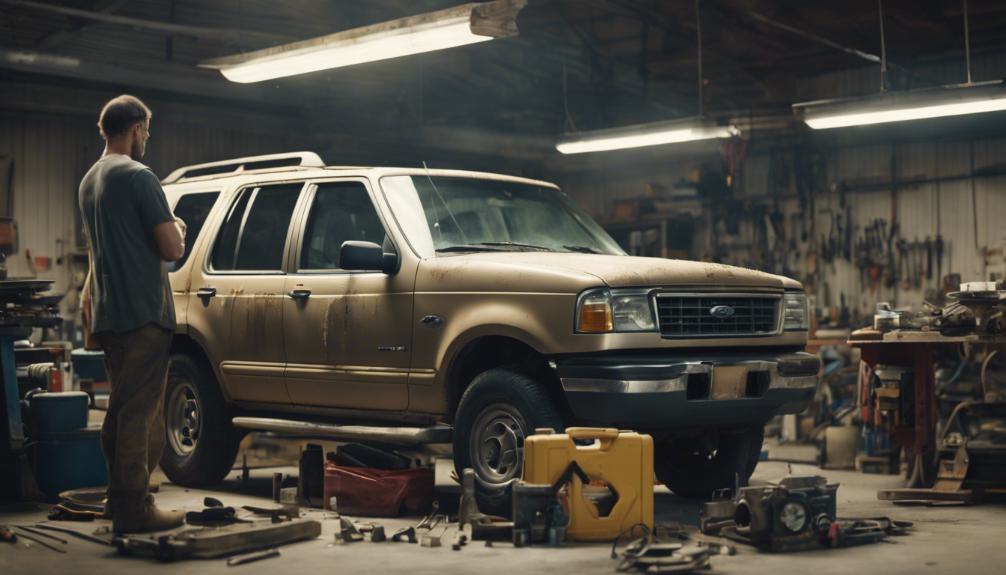Ford Faces Lawsuit for Explorer Subframe Hazard
The Ford Motor Company is currently embroiled in a legal battle that has raised significant safety concerns among consumers, particularly regarding the design of the rear subframe assembly in certain Ford Explorer models. This flaw, characterized by a singular rear axle horizontal mounting bolt, presents a grave risk of the rear driveshaft assembly disengaging during vehicle operation. The implications of such a structural failure are profound, affecting not only vehicle control but also the safety of passengers and other road users. As we examine the complexities of this lawsuit and Ford's response to the allegations, one must consider the broader ramifications for automotive safety standards and consumer trust in the industry.
Key Takeaways
- Ford Explorer models have a critical defect in the rear subframe assembly, posing a severe safety risk.
- Ford knowingly used a less secure single-bolt assembly instead of a safer four-bolt design.
- The defect can lead to total vehicle control loss, increasing collision risks.
- A class action lawsuit targets Ford for not disclosing the defect to consumers and issuing an insufficient recall.
Subframe Defect Overview

The Ford Explorer models have been identified with a critical rear subframe defect, involving a single rear axle horizontal mounting bolt that, upon fracture, precipitates a series of hazardous outcomes including the potential for the rear driveshaft assembly to violently disconnect while the vehicle is in motion. This malfunction not only endangers the passengers within the vehicle but also poses a significant risk to surrounding motorists and pedestrians. The abrupt disconnection can lead to a sudden loss of vehicle control, escalating the likelihood of collisions and jeopardizing public safety. It is crucial for owners and potential buyers to be aware of this flaw to make informed decisions and for regulatory bodies to make sure such safety risks are adequately addressed, reinforcing the commitment to safeguarding all road users.
Rear Subframe Assembly Flaw

Understanding the details of the rear subframe assembly flaw is imperative for grasping the full scope of safety concerns presented by certain Ford Explorer models. This particular defect centers on the rear subframe assembly, which critically depends on a single rear axle horizontal mounting bolt. The fracture of this bolt can precipitate a violent disconnection of the rear driveshaft assembly during vehicle motion. Additionally, failure of the rear subframe bolt may result in the rear differential dropping suddenly. This can lead to the potential destruction of essential components such as the suspension, driveshaft assembly, and exhaust system. The defect's seriousness is underscored by reports from Explorer drivers who express fear over driving their vehicles, highlighting the significant safety concerns this flaw presents.
Potential Driving Hazards

Potential driving hazards stemming from the Ford Explorer's rear subframe defect greatly elevate the risks of catastrophic vehicle failure and collisions. This defect, characterized by the presence of a single rear axle horizontal mounting bolt susceptible to fracture, can precipitate the violent disconnection of the rear driveshaft assembly while the vehicle is in motion. Such a sudden failure not only jeopardizes the structural integrity of the vehicle by potentially damaging the suspension, driveshaft assembly, and exhaust system components but also notably compromises the driver's ability to maintain control. Consequently, the likelihood of unintended and potentially fatal collisions escalates, posing a grave threat to public safety on the roads. It is imperative for those committed to serving others to acknowledge and address these hazards with the urgency they demand.
Consumer Safety Concerns

Consumer safety concerns have escalated considerably due to the discovery of a defective rear subframe assembly in specific Ford Explorer models, posing a severe risk to drivers and passengers alike. The inherent flaw, wherein only one rear axle horizontal mounting bolt is used, greatly compromises vehicle integrity. This defect can precipitate a series of catastrophic failures, including the violent disconnection of the rear driveshaft assembly during motion. Such occurrences not only endanger the lives of those within the vehicle but also pose a substantial threat to all road users. The fear reported by Explorer drivers underscores the urgency of addressing these safety concerns. Ensuring the well-being of consumers should be the paramount priority, necessitating immediate and thorough corrective actions to mitigate further risks.
Ford's Prior Knowledge

Ford's awareness of the need for a four-bolt rear subframe assembly in its Explorer models dates back to at least 2019, indicating a significant lapse in addressing a critical safety issue. This knowledge underscores not just an engineering oversight but a profound failure in prioritizing the well-being and safety of consumers. The choice to continue with a design known to compromise vehicle control and integrity points to a troubling disregard for the potential hazards drivers and their passengers face. For those dedicated to serving others, such revelations compel a reevaluation of trust in brands and highlight the importance of transparency and accountability in corporate practices. Ensuring safety should be paramount, and the delay in rectifying known dangers contradicts this fundamental duty.
Misleading Repair Instructions

In addressing the issue of the Ford Explorer's rear subframe defect, it has come to light that dealers were reportedly instructed to provide misleading information to drivers about the performance issues related to this critical fault. This practice not only undermines the trust between consumers and the automotive industry but also poses a significant risk to public safety. By not being transparent about the severity of the defect, drivers were potentially left unaware of the imminent danger they faced while operating their vehicles. It is essential for companies to prioritize the well-being of their customers and the general public by ensuring clear, honest communication, especially concerning matters that could endanger lives. Misleading repair instructions not only compromise safety but also erode the foundation of consumer trust.
Inadequate Recall Measures

Despite issuing a recall in April 2022, Ford's measures have been criticized for not adequately addressing the significant safety risks associated with the rear subframe defect in certain Explorer models. The recall, intended to mitigate a problem where the rear driveshaft assembly could disconnect due to a fractured mounting bolt, falls short of ensuring the safety and confidence of affected vehicle owners. Concerned individuals, who prioritize the well-being of their families and communities, have voiced their apprehensions. They argue that the recall does not thoroughly resolve the underlying hazard of potential loss of vehicle control. This inadequacy leaves many feeling unsure about the safety of their transportation, emphasizing the need for actions that fully rectify the defect, thereby upholding the paramount value of public safety.
Class Action Lawsuit Details

Given the inadequacies of the recall measures previously mentioned, the focus now shifts to the class action lawsuit filed against Ford concerning the defective rear subframe assembly in certain Explorer models. This legal action underscores the gravity of the situation, aiming to hold Ford accountable for knowingly using a substandard single-bolt rear subframe assembly, which poses a significant risk to drivers and passengers. The lawsuit covers all individuals and entities in the U.S. who have purchased or leased the affected models. It seeks compensation for damages and aims to guarantee such oversight does not recur, emphasizing the importance of consumer safety and corporate responsibility. This collective effort represents a vital step towards rectifying the oversight and safeguarding the well-being of Ford Explorer owners.
Joining the Lawsuit

For individuals and entities affected by the defective rear subframe assembly in certain Ford Explorer models, participating in the class action lawsuit offers a pathway to seeking redress and accountability. By joining the lawsuit, affected parties not only voice their grievances but also contribute to a collective effort aimed at guaranteeing safety standards are upheld and future negligence is deterred. Participation in this legal action requires no upfront cost, allowing for a broad inclusion of affected parties regardless of their financial situation. This inclusivity guarantees that the pursuit of justice and the demand for corporate responsibility are accessible to all who have suffered due to this oversight. Engaging in this lawsuit embodies a commitment to safeguarding community welfare and upholding the rights of consumers.
Broader Legal Challenges

The Ford Explorer subframe lawsuit is part of a wider spectrum of legal challenges confronting the automotive giant, reflecting broader concerns about vehicle safety and corporate accountability. This litigation underscores the critical need for manufacturers to adhere to the highest standards of safety and transparency, especially when defects could endanger lives. The case serves as a reminder of the crucial importance of protecting consumers through diligent oversight and prompt action when potential hazards are identified. It emphasizes the essential role of legal avenues in holding corporations accountable for their actions and decisions. For those committed to serving others, this scenario highlights the importance of advocating for safety, justice, and integrity in product manufacturing and corporate behavior.
Other Ford Lawsuits Context

In addition to the Ford Explorer subframe lawsuit, the automotive giant faces various other legal challenges that underline its ongoing struggles with vehicle safety and manufacturing defects. These legal disputes span a range of issues, including the use of defective valves in EcoBoost engines, showcasing Ford's broader challenges in ensuring the reliability and safety of its vehicles. The lawsuits collectively highlight a pattern of concerns regarding the company's commitment to quality and transparency, affecting consumers' trust and safety. For those dedicated to serving others, understanding the scope of these challenges is essential in advocating for accountability and improved safety standards within the automotive industry. This awareness can empower consumers, stakeholders, and communities to demand better practices and safer products from manufacturers like Ford.
Frequently Asked Questions
How Do I Verify if My Ford Explorer Model Is Affected by the Subframe Defect Without Visiting a Dealer?
To ascertain if your Ford Explorer is impacted by the subframe defect without visiting a dealer, you can refer to the vehicle's identification number (VIN) and compare it against the list of affected models detailed in the public recall notices or Ford's official website. Additionally, contacting Ford's customer service directly via phone or email can provide specific verification. Engaging in online forums or owner groups may also offer insights from other affected individuals.
Are There Any Proactive Measures I Can Take to Prevent the Rear Subframe Assembly Bolt From Failing if My Vehicle Is Potentially Affected?
To fortify your vehicle against the specter of subframe failure, consider a proactive stance. First, schedule a thorough vehicle inspection with a trusted, independent mechanic familiar with the Explorer's specific vulnerabilities. They can assess the integrity of the rear subframe assembly bolt and recommend preemptive measures. Additionally, inquire about aftermarket solutions or enhancements to reinforce this critical area. Prioritizing safety and vigilance can greatly mitigate the risk of sudden mechanical failure.
What Compensation or Remedies Can Affected Ford Explorer Owners Expect if the Class Action Lawsuit Is Successful?
If the class action lawsuit against Ford is successful, affected Ford Explorer owners may expect various forms of compensation or remedies. These could include reimbursement for repairs and related expenses, potential replacement of the defective parts at no cost, and possibly damages for loss of vehicle value. Additionally, owners might receive extended warranties or monetary compensation for inconvenience and safety concerns. The specific remedies will depend on the lawsuit's outcomes and settlement terms.
How Long Might the Legal Process Take Before a Resolution Is Reached in the Class Action Lawsuit Against Ford for the Subframe Defect?
While it's understandable to be concerned about the duration of legal proceedings, it's vital to recognize that class action lawsuits, especially those of significant magnitude like the one against Ford for the subframe defect, can be complex and lengthy. The process may span several months to years, depending on the litigation's intricacies, negotiation processes, and court schedules. Patience and persistence are key, as the outcome could provide substantial relief and rectification for affected parties.
Can Affected Ford Explorer Owners Seek Individual Legal Action Against Ford in Addition to or Instead of Joining the Class Action Lawsuit?
Affected Ford Explorer owners may explore the option of filing individual lawsuits against Ford for the subframe defect, in addition to or as an alternative to joining the class action lawsuit. This legal avenue allows for the pursuit of specific damages and remedies that may not be fully addressed through class action participation. Consulting with legal counsel can provide clarity on the most advantageous course of action based on the unique circumstances of each case.
Conclusion
To sum up, amidst the shadows of legal battles and public scrutiny, Ford Motor Company's recent lawsuit concerning a critical subframe defect in its Explorer model illuminates broader issues of automotive safety and corporate responsibility. This case, a confluence of technical oversight and delayed response, not only jeopardizes consumer trust but also serves as a pivotal moment for industry-wide introspection. It underscores the imperative for automotive manufacturers to prioritize safety over silence, ensuring such oversights are promptly and transparently addressed.

This post has been generated by AI and was not reviewed by editors. This is Not legal advice. Please consult with an attorney.
